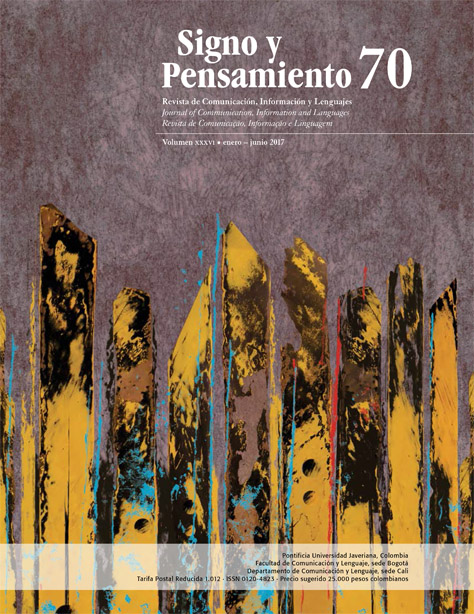Resumen
Esta investigación analiza acciones particulares de ciudadanías comunicativas de la sociedad civil: maniobras desarrolladas en medio de la contienda por la apropiación del espacio público en zonas urbanas que han padecido altos índices de violencia en la ciudad de Medellín, Colombia.
Principalmente, esta pesquisa indaga por cómo diversas acciones de ciudadanías comunicativas generan procesos de construcción de memoria colectiva, inclusión social, reconocimiento de las diferencias y reclamación de derechos humanos por parte de públicos subalternos en la arena pública.
Alexander, J. (1997). The Paradoxes of Civil Society. International Sociology, 12(2), 115-133.
Alexander, J. (2004). Cultural Trauma and Collective Identity. California: University of California Press.
Alexander, J. (2013). Legitimation Crisis: Recovering the performance of Power. Culture, 26(3), 8-10. Alexander, J. (2011). Performance and Power. Cambridge: Polity Press.
Alexander, J. (2006). The Civil Sphere. Oxford: Oxford University Press.
Alexiévich, S. (2015). La guerra no tiene rostro de mujer. Bogotá: Penguin Random House Grupo Editorial.
Angarita, P. (2008). Dinámicas de Guerra y construcción de paz. Medellín: Universidad de Antioquia.
Arnold de Simine, S y Radstone, S. (2013). The GDR and the Memory Debate. A. Saunders y D. Pinfold (eds), Remembering and Rethinking the GDR: Multiple Perspectives and Plural Authenticities (pp. 19-34). Hampshire, UK: Palgrave Macmillan.
Bourdieu, P. (1977). Outline of a Theory of Practice. Cambridge, UK: Cambridge University Press. Bourdieu, P. (1984). Distinction: A Social Critique of the Judgement of Taste. London, UK: Routledge.
Bourdieu, P. (1990). The Logic of Practice. Stanford, USA: Stanford University Press.
Blair, E., Grisales, M. y Muñoz, M. (2009). Conflictividades urbanas vs. Guerra urbana: otra clave para leer el conflicto en Medellín. Universitas Humanística, 67, 29-54. Coordinación Colombia Europa Estados Unidos – CCEEU. (2014). Estado de los Derechos Humanos en Antioquia Entre el sueño de la paz y la continuidad de la guerra. Medellín: Observatorio de DDHH del IPC.
Corpovisionarios. (2013). Indicadores de Cultura Ciudadana en Medellín. Medellín, Colombia. Defensoría del Pueblo. (2013). Informe de riesgo No 008-13. Medellín: Defensoría del Pueblo. Duncan, G y
Eslava, A. (2015). Territorio, crimen, comunidad. Heterogeneidad del homicidio en Medellín. Medellín: Universidad EAFIT. Giraldo, J., Rendón, A. y Duncan, G. (2014). Nue- vas modalidades de captación de rentas ilegales en Medellín. Medellín: Universidad EAFIT. Giraldo, J. (2008). Conflicto armado urbano y violencia homicida: el caso de Medellín. Revista Latinoamericana de Seguridad Ciudadana, 5, 45-64.
Halbwachs, M. (1995). Memoria colectiva y memoria histórica. Revista española de publicaciones sociológicas, 69, 209-214.
Insight Crime (2013). Las víctimas nómadas: Desplazamiento intraurbano en Medellín. Recu- perado de http://es.insightcrime.org/analisis/ las-victimas-nomadas-desplazamiento-intra- urbano-en-medellin
Instituto Popular de Capacitación. (2015). Des- plazados de San Gabriel: “Desprotegidos en La Loma y también afuera”. Medellín: Observa- torio de DDHH del IPC.
Polletta, F. y Gardner, B.G. (2015). Narrative and Social Movements. En D. Della Porta y M. Diani (ed.), The Oxford Handbook of Social Movements (pp. 534-548). Oxford, Reino Unido: Oxford Press University
Tamayo, C. (2012). The Instrumentalization of the Communicative Citizenship Field in the Context of Armed Conflict: The Case of the Association of Organized Women of Eastern Antioquia in Colombia. En P. Cunningham y N. Fretwell (eds.), Creating Communities: Local, National and Global (755-767). London: CiCe.
Whitehead, A. (2009). Memory, the New Critical Idiom. Nueva York, USA: Routledge.
Alexander, J. (2004). Cultural Trauma and Collective Identity. California: University of California Press.
Alexander, J. (2013). Legitimation Crisis: Recovering the performance of Power. Culture, 26(3), 8-10. Alexander, J. (2011). Performance and Power. Cambridge: Polity Press.
Alexander, J. (2006). The Civil Sphere. Oxford: Oxford University Press.
Alexiévich, S. (2015). La guerra no tiene rostro de mujer. Bogotá: Penguin Random House Grupo Editorial.
Angarita, P. (2008). Dinámicas de Guerra y construcción de paz. Medellín: Universidad de Antioquia.
Arnold de Simine, S y Radstone, S. (2013). The GDR and the Memory Debate. A. Saunders y D. Pinfold (eds), Remembering and Rethinking the GDR: Multiple Perspectives and Plural Authenticities (pp. 19-34). Hampshire, UK: Palgrave Macmillan.
Bourdieu, P. (1977). Outline of a Theory of Practice. Cambridge, UK: Cambridge University Press. Bourdieu, P. (1984). Distinction: A Social Critique of the Judgement of Taste. London, UK: Routledge.
Bourdieu, P. (1990). The Logic of Practice. Stanford, USA: Stanford University Press.
Blair, E., Grisales, M. y Muñoz, M. (2009). Conflictividades urbanas vs. Guerra urbana: otra clave para leer el conflicto en Medellín. Universitas Humanística, 67, 29-54. Coordinación Colombia Europa Estados Unidos – CCEEU. (2014). Estado de los Derechos Humanos en Antioquia Entre el sueño de la paz y la continuidad de la guerra. Medellín: Observatorio de DDHH del IPC.
Corpovisionarios. (2013). Indicadores de Cultura Ciudadana en Medellín. Medellín, Colombia. Defensoría del Pueblo. (2013). Informe de riesgo No 008-13. Medellín: Defensoría del Pueblo. Duncan, G y
Eslava, A. (2015). Territorio, crimen, comunidad. Heterogeneidad del homicidio en Medellín. Medellín: Universidad EAFIT. Giraldo, J., Rendón, A. y Duncan, G. (2014). Nue- vas modalidades de captación de rentas ilegales en Medellín. Medellín: Universidad EAFIT. Giraldo, J. (2008). Conflicto armado urbano y violencia homicida: el caso de Medellín. Revista Latinoamericana de Seguridad Ciudadana, 5, 45-64.
Halbwachs, M. (1995). Memoria colectiva y memoria histórica. Revista española de publicaciones sociológicas, 69, 209-214.
Insight Crime (2013). Las víctimas nómadas: Desplazamiento intraurbano en Medellín. Recu- perado de http://es.insightcrime.org/analisis/ las-victimas-nomadas-desplazamiento-intra- urbano-en-medellin
Instituto Popular de Capacitación. (2015). Des- plazados de San Gabriel: “Desprotegidos en La Loma y también afuera”. Medellín: Observa- torio de DDHH del IPC.
Polletta, F. y Gardner, B.G. (2015). Narrative and Social Movements. En D. Della Porta y M. Diani (ed.), The Oxford Handbook of Social Movements (pp. 534-548). Oxford, Reino Unido: Oxford Press University
Tamayo, C. (2012). The Instrumentalization of the Communicative Citizenship Field in the Context of Armed Conflict: The Case of the Association of Organized Women of Eastern Antioquia in Colombia. En P. Cunningham y N. Fretwell (eds.), Creating Communities: Local, National and Global (755-767). London: CiCe.
Whitehead, A. (2009). Memory, the New Critical Idiom. Nueva York, USA: Routledge.

Esta obra está bajo una licencia internacional Creative Commons Atribución 4.0.
Derechos de autor 2017 Camilo Tamayo Gómez, Daniela Navarro Bohórquez
Downloads
Download data is not yet available.



